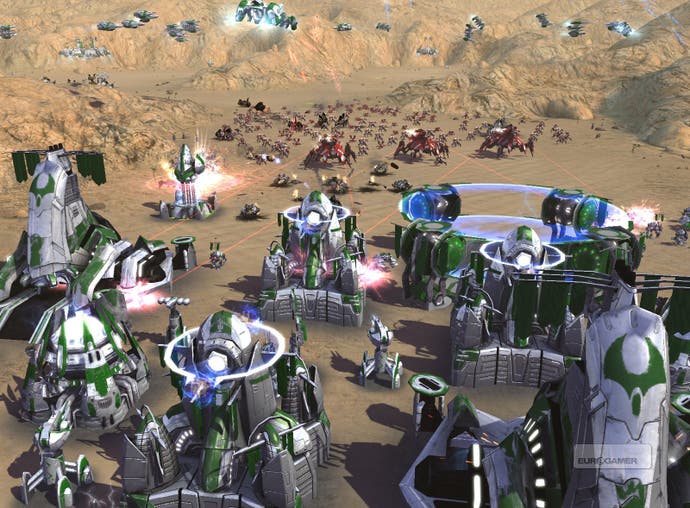Supreme Commander 2
Experimentally unexperimental.
Supreme Commander is a fearsome beast of an RTS: utterly bewildering to anyone who isn't a long-term veteran of the PC's most mainstay genre, but profoundly satisfying to those who have always sworn by base-building. With Supreme Commander 2, Gas Powered Games wants to bring everyone in from the cold instead, as you can read in last week's Supreme Commander 2 preview.
But how the bleeding crikey do you make an RTS that's about shuffling hundreds of tiny, futuristic tanks across maps the size of Wales accessible? Eurogamer sat down with Gas Powered Games' mile-a-minute CEO Chris Taylor, the hyper-brain behind the likes of Total Annihilation and Dungeon, and made him say words. Lots of words.
See when people sequel games, they tend to give it a paint job, add a little of this, a little of that. But you get the same core experience. We, on the other hand, completely rewrote the rendering engine. The old one used a dynamically tessallating model so that as you zoomed in and out there were different levels of triangle density and then the CPU had to push that over the bus to the GPU. It actually gobbled up a lot of the system performance, made the game require a pretty beefy system. This game we've improved that so that we push the geometry over, and we leave it there. It's a better architecture.
It's also got a brand new lighting model - we use a global illumination model, we use a point-cloud system, all-new shadowing, all-new water, new pathfinding system. You provide one graph, one destination on a map that will take every unit from that location to that point. So it's a wonderful system for moving hundreds of units. The other thing we've added is a little bit of neural net AI as well as the handcrafted AI we already use. With neural net AI, you run a hundred thousand simulations, and you build a database of tendencies - it can bring a more natural and a smarter opponent to the AI.

Really the top of the list was to tell a story in the single-player campaign that has a focus on the characters. Think of the difference between watching the History Channel where it's all about Rommell and Patton, or instead watching Saving Private Ryan, where it's all about taking the girl up the barn, and how when they were kids they played together and oh, the roses... Y'know, all the stuff that takes us into the lives of the characters. That's an extreme example, but when you go away from the high-level History Channel version you get a more interesting story. In our story, it's about where do your loyalties lie, at home with your family or with your country? It's a good story, because it tests the character.
We go into the lives of our characters: we have a father-son story that we tell, we have a brother and a sister story. Going into battle, these characters are dialoguing during the fights, and you have these moments where it's really cool to feel you're in a sibling situation, or later where you're thinking, "I don't wanna do what dad tells me to do." We're trying to be place these characters in the cockpits. It's neat to be able to walk through that kind of experience. That's number one for us in this game. For most of the mission briefings, we're actually doing it in-game, rather than having all these bleeping screens you have to sit through first, saying "you must attack from the south..." We really put you right in the game and feed you the information you need.



